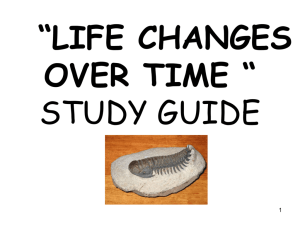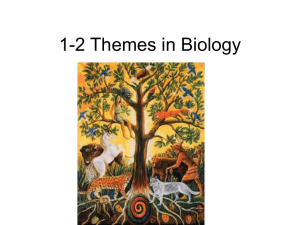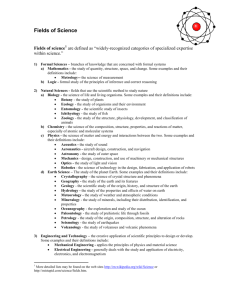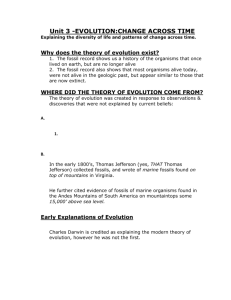Physical Science Grade 3
advertisement
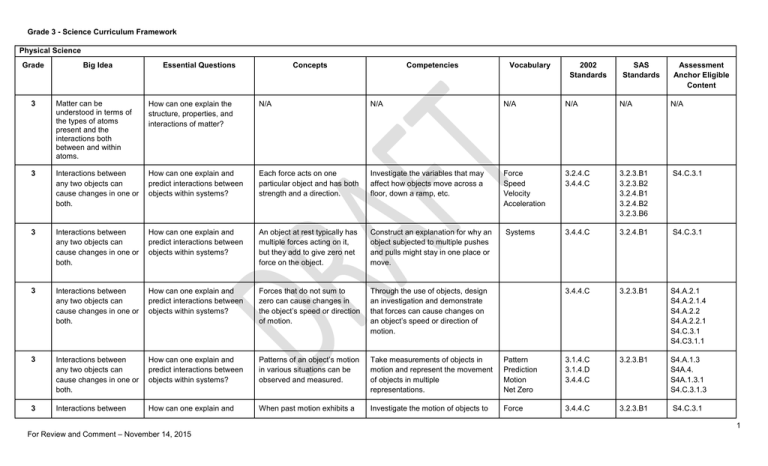
Grade 3 - Science Curriculum Framework Physical Science Grade Big Idea Essential Questions Concepts Competencies Vocabulary 2002 Standards SAS Standards Assessment Anchor Eligible Content 3 Matter can be understood in terms of the types of atoms present and the interactions both between and within atoms. How can one explain the structure, properties, and interactions of matter? N/A N/A N/A N/A N/A N/A 3 Interactions between any two objects can cause changes in one or both. How can one explain and predict interactions between objects within systems? Each force acts on one particular object and has both strength and a direction. Investigate the variables that may affect how objects move across a floor, down a ramp, etc. Force Speed Velocity Acceleration 3.2.4.C 3.4.4.C 3.2.3.B1 3.2.3.B2 3.2.4.B1 3.2.4.B2 3.2.3.B6 S4.C.3.1 3 Interactions between any two objects can cause changes in one or both. How can one explain and predict interactions between objects within systems? An object at rest typically has multiple forces acting on it, but they add to give zero net force on the object. Construct an explanation for why an object subjected to multiple pushes and pulls might stay in one place or move. Systems 3.4.4.C 3.2.4.B1 S4.C.3.1 3 Interactions between any two objects can cause changes in one or both. How can one explain and predict interactions between objects within systems? Forces that do not sum to zero can cause changes in the object’s speed or direction of motion. Through the use of objects, design an investigation and demonstrate that forces can cause changes on an object’s speed or direction of motion. 3.4.4.C 3.2.3.B1 S4.A.2.1 S4.A.2.1.4 S4.A.2.2 S4.A.2.2.1 S4.C.3.1 S4.C3.1.1 3 Interactions between any two objects can cause changes in one or both. How can one explain and predict interactions between objects within systems? Patterns of an object’s motion in various situations can be observed and measured. Take measurements of objects in motion and represent the movement of objects in multiple representations. Pattern Prediction Motion Net Zero 3.1.4.C 3.1.4.D 3.4.4.C 3.2.3.B1 S4.A.1.3 S4A.4. S4A.1.3.1 S4.C.3.1.3 3 Interactions between How can one explain and When past motion exhibits a Investigate the motion of objects to Force 3.4.4.C 3.2.3.B1 S4.C.3.1 1 For Review and Comment – November 14, 2015 Grade 3 - Science Curriculum Framework any two objects can cause changes in one or both. predict interactions between objects within systems? regular pattern, future motion can be predicted from it. determine observable and measurable patterns to predict future motions Net Force Predict Pattern Gravity 3.4.4.D 3.2.4.B1 3 Interactions between any two objects can cause changes in one or both. How can one explain and predict interactions between objects within systems? When past motion exhibits a regular pattern, future motion can be predicted from it. Provide evidence that a pattern can be used to predict future motion. Force Pattern 3.4.4.C 3.4.4.D 3.2.3.B1 3.2.4.B1 S4.C.3.1 3 Interactions between any two objects can cause changes in one or both. How can one explain and predict interactions between objects within systems? Objects in contact exert forces on each other. Design and implement an investigation to demonstrate that objects in contact exert forces on each other. 3.4.4.C 3.2.3.B1 S4.A.2.1 S4.A.2.1.4 S4.A.2.2 S4.A.2.2.1 S4.C.3.1 S4.C3.1.1 3 Interactions of objects or systems of objects can be predicted and explained using the concept of energy transfer and conservation. How is energy transferred and conserved? N/A N/A N/A N/A N/A N/A 3 Waves are a repeating pattern of motion that transfers energy from place to place without overall displacement of matter. How are waves used to transfer energy and information? N/A N/A N/A N/A N/A N/A Life Science Grade Big Idea Essential Questions 3 All organisms are made How do organisms live, grow, Concepts Reproduction is essential to Competencies Use models to explain how Vocabulary Parents 2002 Standards 3.3.4.C SAS Standards 3.1.4.A Assessment Anchor Eligible Content S4.A.3.2 2 For Review and Comment – November 14, 2015 Grade 3 - Science Curriculum Framework 3 3 3 of cells and can be characterized by common aspects of their structure and functioning. respond to their environment, and reproduce? the continued existence of every kind of organisms. reproduction is essential for every kind of organism. Offspring Survival Reproduce Life Cycle 3.1.4.B 3.1.4.B 3.1.4.C 4.1.4.A 4.5.4.D 4.2.4.C S4.B.1.1.5 All organisms are made of cells and can be characterized by common aspects of their structure and functioning. How do organisms live, grow, respond to their environment, and reproduce? Plants and animals have unique and diverse life cycles that include birth, growth, reproduction, and death. Develop a model to describe the commonalities of life cycles of different organisms. Parents Offspring Survival Reproduce Life Cycle 3.3.4.A 3.1.4.B 3.1.4.A 3.1.4.B 3.1.4.C 4.1.4.A 4.5.4.D 4.2.4.C S4.A.3.2. S4.B.1.1.5 Organisms grow, reproduce, and perpetuate their species by obtaining necessary resources through interdependent relationships with other organisms and the physical environment. How and why do organisms interact with their environment and what are the effects of these interactions? Animals depend on each other and their surroundings to get what they need, including food, water, shelter, and a stable temperature. Groups serve different functions and vary in size. Based on observations, construct an argument that some animals form groups that help members survive. Representation Consumer Heterotroph Stable Basic needs 3.2.4.A 3.3.4.A 4.6.4.A 3.1.4.A 3.1.4.C 3.2.4.A 3.2.4.B 3.3.4.B 3.4.4.A 3.4.4.B 3.4.4.E 4.1.4.A 4.1.4.B 4.1.4.C 4.2.4.A 4.2.4.B 4.2.4.C 4.4.4.B 4.5.4.D S4.A.3.1.2 S4.A.3.1.3 S4.B.2.1.1 S4.B.3.1.1 Organisms grow, reproduce, and perpetuate their species by obtaining necessary resources through interdependent relationships with other How and why do organisms interact with their environment and what are the effects of these interactions? When the environment changes in physical characteristics, temperature, availability of resources, some organisms survive, others move, yet others may die. Construct an argument with evidence that within a specific habitat, some organisms survive well, some not so well, and others cannot survive at all. 3.3.4.D 3.1.4.A 3.1.4.B 3.1.4.C 3.1.4.E 3.2.4.A 3.2.4.B 3.3.4.A S4.B.3.2.1 S4.B.3.2.2 S4.B.3.2.3 S4.A.1.1.1 S4.A.1.3.2 S4.A.1.3.4 S.4.A.3.2.1 3 For Review and Comment – November 14, 2015 Grade 3 - Science Curriculum Framework organisms and the physical environment. How are the characteristics of one generation passed to the next? How can individuals of the same species and even siblings have different characteristics? Different organisms vary in how they look and function because they have different inherited information. 3 Heredity refers to specific mechanisms by which characteristics or traits are passed from one generation to the next via genes, and explains why offspring resemble, but are not identical to, their parents. Analyze and interpret data to provide evidence that plants and animals have traits inherited from parents and that variation of these traits exists in a group of similar organisms. How are the characteristics of one generation passed to the next? How can individuals of the same species and even siblings have different characteristics? The environment also affects the traits that an organism develops. Use evidence to support an explanation that the environment can influence traits. 3 Heredity refers to specific mechanisms by which characteristics or traits are passed from one generation to the next via genes, and explains why offspring resemble, but are not identical to, their parents. 3 Heredity refers to specific mechanisms by which characteristics or traits are passed from How are the characteristics of one generation passed to the next? How can individuals of the same species and even Many characteristics involve both inherited traits and environmental factors. Use evidence to compare characteristics inherited from parents, characteristics caused by the environment, and those resulting Traits Inheritance Characteristics Inherited Traits Variation 3.3.4.B 3.4.4.B 3.4.4.D 3.4.4.E 4.1.4.A 4.1.4.E 4.4.4.A 4.4.4.D 4.5.4.A 4.5.4.C S4.A.3.3.2 3.3.4.C 3.1.3.B1 S4.A.2.1.3 S4.B.2.2. 3.3.4.C 3.1.3.B1 S4.A.2.1.3 S4.B.2.2. 3.3.4.C 3.1.4.A 3.1.4.B 3.1.4.C 4.5.4.D S4.B.2.1.1 S4.B.2.2.1 4 For Review and Comment – November 14, 2015 Grade 3 - Science Curriculum Framework one generation to the next via genes, and explains why offspring resemble, but are not identical to, their parents. siblings have different characteristics? How can there be so many similarities among organisms yet so many different kinds of plants, animals, and microorganisms? Some plants and animals that once lived on earth are no longer found anywhere. Analyze and interpret data from fossils to provide evidence of the organisms and environments in which they lived long ago. Fossils Extinct 4.7.4.C 3 Biological evolution explains both the unity and diversity of species and provides a unifying principle for the history and diversity of life on Earth. How can there be so many similarities among organisms yet so many different kinds of plants, animals, and microorganisms? Fossils provide evidence about types of organisms that lived long ago as well as about the nature of the environment. Analyze and interpret data from fossils to provide evidence of the organisms and environments in which they lived long ago. Fossils Extinct 4.7.4.C 3.1.2.C3 3.1.3.C3 S.4.A.2.1.4 3 Biological evolution explains both the unity and diversity of species and provides a unifying principle for the history and diversity of life on Earth. Biological evolution explains both the unity and diversity of species and provides a unifying principle for the history and diversity of life on Earth. How can there be so many similarities among organisms yet so many different kinds of plants, animals, and microorganisms? Changes in an organism's habitat can be beneficial or harmful to the organism. Use evidence to argue that when the environment changes in ways that affect a place’s physical characteristics, organisms may survive, move to new locations, or die. Endangered Habitat Adapt 3.3.4.D 4.7.4.A 4.7.4.B 3.1.4.A 3.1.4.B 3.1.4.C 3.1.4.E 3.2.4.A 3.2.4.B 3.3.4.A 3.3.4.B 3.4.4.B 3.4.4.D 3.4.4.E 4.1.4.A 4.1.4.E 4.4.4.A S4.B.3.2.1 S4.B.3.2.2 S4.B.3.2.3 S4.A.1.1.1 S4.A.1.3.2 S4.A.1.3.4 S.4.A.3.2.1 S4.A.3.3.2 3 from both. Environmental Factors 4.2.4.C Siblings Generation S.4.A.2.1.4 5 For Review and Comment – November 14, 2015 Grade 3 - Science Curriculum Framework 4.4.4.D 4.5.4.A 4.5.4.C Biological evolution explains both the unity and diversity of species and provides a unifying principle for the history and diversity of life on Earth. How can there be so many similarities among organisms yet so many different kinds of plants, animals, and microorganisms? Populations live in a variety of habitats and changes in those habitats impacts the organisms living there. Using evidence, make a claim about merits of solutions to problems caused when the environment changes and types of animals and plants that live there may change. 3 Biological evolution explains both the unity and diversity of species and provides a unifying principle for the history and diversity of life on Earth. How can there be so many similarities among organisms yet so many different kinds of plants, animals, and microorganisms? Sometimes differences in characteristics between individuals of the same species provide advantages in surviving, finding mates, and reproducing. Use evidence to construct an explanation for how the variations in characteristics among individuals of the same species may provide advantages in surviving, finding mates, and reproducing. 3 Biological evolution explains both the unity and diversity of species and provides a unifying principle for the history and diversity of life on Earth. How can there be so many similarities among organisms yet so many different kinds of plants, animals, and microorganisms? Fossils provide evidence about the types of organisms (both visible and microscopic) that lived long ago and also about the nature of their environments. Use evidence to construct an explanation that some rocks and minerals record the remains of organisms. Populations Habitats 3.3.4.D 4.8.4.C 3.3.4.D 4.7.4.A 4.7.4.B 3 3.1.4.A 3.1.4.B 3.1.4.C 3.1.4.E 3.2.4.A 3.2.4.B 3.3.4.A 3.3.4.B 3.4.4.B 3.4.4.D 3.4.4.E 4.1.4.A 4.1.4.E 4.4.4.A 4.4.4.D 4.5.4.A 4.5.4.C 4.7.4.A 4.7.4.B Fossils Microscopic 3.5.4.A 4.7.4.B S4.B.3.2.1 S4.B.3.2.2 S4.B.3.2.3 S4.A.1.1.1 S4.A.1.3.2 S4.A.1.3.4 S.4.A.3.2.1 S4.A.3.3.2 S4.A.1.3.4 3.1.4.A 3.1.4.C 4.5.4.D 4.2.4.C S4.B.2.1.2 6 For Review and Comment – November 14, 2015 Grade 3 - Science Curriculum Framework Biological evolution explains both the unity and diversity of species and provides a unifying principle for the history and diversity of life on Earth. How can there be so many similarities among organisms yet so many different kinds of plants, animals, and microorganisms? Fossils provide evidence about the types of organisms (both visible and microscopic) that lived long ago and also about the nature of their environments. Obtain and communicate information that some organisms that once lived on earth are no longer found anywhere, although other organisms now may resemble them. Organism 3 Biological evolution explains both the unity and diversity of species and provides a unifying principle for the history and diversity of life on Earth. How can there be so many similarities among organisms yet so many different kinds of plants, animals, and microorganisms? Fossils can be compared with one another and to living organisms according to their similarities and differences. Use evidence from fossil records to construct an explanation of the relationship between types of organisms living today and types of organisms that lived in the past. 3 Biological evolution explains both the unity and diversity of species and provides a unifying principle for the history and diversity of life on Earth. How can there be so many similarities among organisms yet so many different kinds of plants, animals, and microorganisms? Fossils can be compared with one another and to living organisms according to their similarities and differences. 3 Biological evolution explains both the unity and diversity of species and provides a unifying principle for the history and diversity of life on Earth. How can there be so many similarities among organisms yet so many different kinds of plants, animals, and microorganisms? 3 Biological evolution explains both the unity and diversity of species and provides a unifying principle for the history How can there be so many similarities among organisms yet so many different kinds of plants, animals, and microorganisms? 3 3.5.4.A 3.3.4.D 3.1.4.A 3.1.4.C 4.5.4.D 4.2.4.C S4.B.2.1.2 Fossil Record Explanation 3.5.4.A 3.1.3C3 3.1.4.A 3.1.4.C 4.5.4.D 4.2.4.C S4.B.2.1.2 Use evidence to construct explanations for how environments today may be different from past environments in which fossilized organisms once lived. Fossil 3.5.4.A 3.1.4.A 3.1.4.C 4.5.4.D 4.2.4.C S4.B.2.1.2 Sometimes the differences in characteristics between individuals of the same species provide advantages in surviving, finding mates, and reproducing. Use evidence to explain how some characteristics that vary among individuals of the same kind of organism can provide advantages to survive, find mates, and reproduce. Survive Reproduce 3.3.4.A 3.1.3.C1 3.1.4.A 3.1.4.C 4.5.4.D 4.2.4.C S4.B.2.1.2 Humans, like all other organisms, obtain living and nonliving resources from their environments. Use evidence to demonstrate how humans, like all other organisms, obtain living and non-living resources from their environment. Living Non-Living 3.3.4.A 3.1.4.A 3.1.4.C 3.1.4.E 3.2.4.A 3.2.4.B S4.B.3.3.1 S4.B.3.3.2 S4.B.3.3.3 S4.B.3.3.4 S4.B.3.3.5 Visible Organism Microscopic Organism 7 For Review and Comment – November 14, 2015 Grade 3 - Science Curriculum Framework and diversity of life on Earth. 3.3.4.B 3.4.4.A 3.4.4.B 3.4.4.E 3.4.4.D 4.1.4.A 4.1.4.B 4.1.4.E 4.2.4.A 4.3.4.A 4.4.4.A 4.4.4.B 4.4.4.D 4.5.4.A 4.5.4.C S4.A.1.1.2 S4.A.1.3.5 S4.A.3.1.4 Earth and Space Science Big Idea Essential Question Concepts Competencies Vocabulary Grade What is the universe, and what is Earth’s place in it? N/A N/A N/A 3 The universe is composed of a variety of different objects, which are organized into systems each of, which develops according to accepted physical processes and laws. How and why is Earth constantly changing? Scientists record patterns of the weather across different times and areas of the weather so that they can make predictions about what kind of weather might happen next. Organize simple weather data sets to record local weather data and identify day-to-day variations, as well as, long-term patterns of weather. Weather Data Atmosphere 3 The Earth is a complex and dynamic set of interconnected systems (e.g. geosphere, hydrosphere, atmosphere, biosphere) that interact over a wide 2002 Standards 3.1.4.E 3.5.4.C SAS Standards Assessment Anchor Eligible Content N/A N/A 3.3.3.A4 3.3.3.A5 S4.A.1.1 S4.A.1.3 S.4.A.1.3.1 S4.A.2.1 S4.A.2.2 S4.A.3.1 8 For Review and Comment – November 14, 2015 Grade 3 - Science Curriculum Framework range of temporal and spatial scales. S4.A.3.2 S4.A.3.3 How and why is Earth constantly changing? Climate describes a range of an area's typical weather conditions and the extent to which those conditions vary over a period of many years. Record and communicate information to describe climates in different regions of the world. Weather Climate Conditions 3.5.4.C 3.3.3.A4 3.3.3.A5 3 The Earth is a complex and dynamic set of interconnected systems (e.g. geosphere, hydrosphere, atmosphere, biosphere) that interact over a wide range of temporal and spatial scales. S4.A.1.1 S4.A.1.3 S4.A.2.1 S4.A.2.2 S4.A.3.1 S.4.A.1.3.1 S4.A.3.2 S4.A.3.3 How and why is Earth constantly changing? Climate describes a range of an area's typical weather conditions and the extent to which those conditions vary over a period of many years. Display simple data sets in tables and graphs to display previous weather conditions to make predictions for future seasons. Weather Climate 3.1.4.C 3.5.4.C 3.3.3.A4 3.3.3.A5 3 The Earth is a complex and dynamic set of interconnected systems (e.g. geosphere, hydrosphere, atmosphere, biosphere) that interact over a wide range of temporal and spatial scales. S4.A.1.1 S4.A.1.3 S4.A.2.1 S4.A.2.2 S4.A.3.1 S4.A.3.2 S4.A.3.3 The Earth’s processes affect and are affected by human activities. How do Earth’s processes and human activities affect each other? N/A N/A N/A N/A N/A N/A 3 9 For Review and Comment – November 14, 2015
